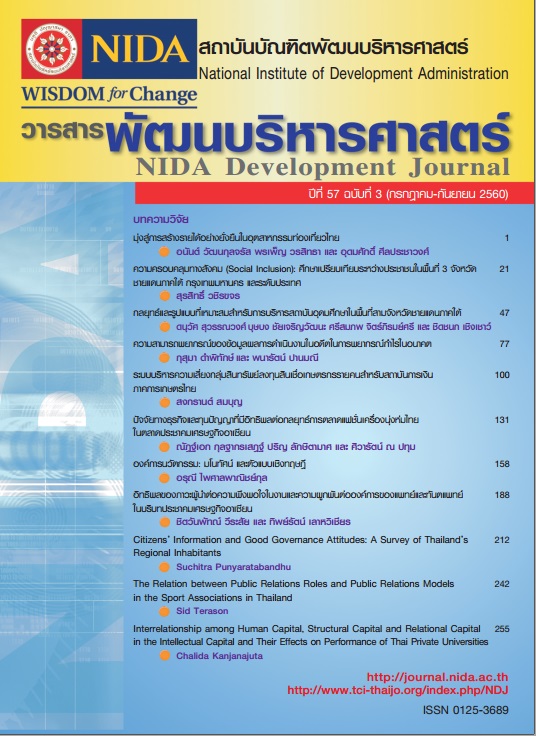ระบบบริหารความเสี่ยงกลุ่มสินทรัพย์ลงทุนสินเชื่อเกษตรกรรายคน สำหรับสถาบันการเงินภาคการเกษตรไทย
Keywords:
การบริหารความเสี่ยงด้านสินเชื่อ, กลุ่มสินทรัพย์ลงทุนสินเชื่อ, สถาบันการเงินภาคการเกษตร, Credit Risk Management, Loan Portfolio, Agricultural Financial InstitutionAbstract
การศึกษานี้ มีวัตถุประสงค์เพื่อพัฒนาระบบบริหารความเสี่ยงกลุ่มสินทรัพย์ลงทุนสินเชื่อเกษตรกรรายคน สำหรับนำมาใช้ในกิจกรรมการจ่ายสินเชื่อแก่ผู้ขอกู้รายใหม่ของธนาคารเพื่อการเกษตรและสหกรณ์การเกษตรซึ่งเป็นสถาบันการเงินภาคการเกษตรที่สำคัญของประเทศไทย เนื้อหานำเสนอการพัฒนาแบบจำลองโลจิท และแบบจำลองโครงข่ายประสาทเทียม เพื่อระบุความน่าจะเป็นที่ลูกหนี้จะผิดนัดชำระคืนหนี้จากปัจจัยเสี่ยงทางเศรษฐศาสตร์และภูมิศาสตร์ แบบจำลองทั้งสองผ่านการทดสอบความน่าเชื่อถือถึงประสิทธิภาพในการทำนายและการจำแนกกลุ่มลูกหนี้ด้วยเทคนิคทางสถิติและสถิติทดสอบ ซึ่งงานศึกษานี้สนับสนุนให้ประยุกต์สร้างระบบบริหารความเสี่ยงจากแบบจำลองโลจิท เนื่องจากให้ค่าการทำนายถูกต้องแม่นยำที่สูงกว่า และให้ค่าต้นทุนแห่งการจำแนกผิดที่ต่ำกว่าแบบจำลองโครงข่ายประสาทเทียม ผลลัพธ์ที่ได้จากแบบจำลองโลจิท ถูกนำมาพัฒนาระบบการให้คะแนนสินเชื่อ และระบบการจัดอันดับชั้นความเสี่ยงสินเชื่อภายในโดยอ้างอิงวิธี advanced internal rating based approach (AIRB approach) ตามการกำกับดูแลสถาบันการเงินมาตรฐานสากลเกณฑ์บาเซิลทู ผลการศึกษาแสดงให้เห็นถึงการนำระบบที่พัฒนาขึ้นมาช่วยบริหารความเสี่ยงในกิจกรรมจ่ายสินเชื่อให้แก่เกษตรกรผู้ขอกู้รายใหม่ของธนาคาร เช่น การกระจายความเสี่ยงเพื่อจัดอันดับคุณภาพสินเชื่อ การคำนวณเงินกองทุนขั้นต่ำที่ต้องดำรงรองรับความเสียหาย การกำหนดอัตราดอกเบี้ยเงินกู้ตามค่าความเสี่ยง และการคำนวณหาผลตอบแทนของกลุ่มสินทรัพย์ลงทุนสินเชื่อที่เหมาะสม
Credit Risk Management System for Managing Risk in Farmer Loan Portfolio of the Agricultural Financial Institution in Thailand
Abstract
The main objective of this study is to develop a credit risk management system for managing risk in front-end farmer loan portfolio of the Bank for Agriculture and Agricultural Cooperatives, an important organization of the agricultural financial institution in Thailand. The LOGIT model and the artificial neural network (ANN) model are developed to identify the probability of default from the economical and geographical risk factors. The models are tested for validity of the prediction power in discriminating the debtors. The study supports the use of LOGIT model to application of the credit risk management systems. It is found that the LOGIT model gives more accurately and lower misclassification costs than the ANN model. The results from the LOGIT model are subsequently employed to develop a credit scoring system and an internal credit risk rating system with complied to the advanced internal ratings based approach (AIRB approach) in the Basel II capital accord. The study has been shown how front-end agricultural exposure is typically can be managed on the portfolio basis which will enable the bank to diversify the risk in each of portfolio shares, analyze for the minimum capital requirements in the portfolio, determine the interest rate on the basis of risk in each of borrower, and optimal returns in the farmer loan portfolio.





